Organisational Behaviour: Influence of Culture, Motivation and Teams
VerifiedAdded on 2023/06/05
|15
|4459
|261
Report
AI Summary
This report provides a comprehensive analysis of organisational behaviour, focusing on the influence of culture, politics, and power on individual and team behaviour within organisations like Jimmy Choo. It evaluates content and process theories of motivation, including Maslow's hierarchy of needs, Herzberg's two-factor theory, Skinner's reinforcement theory, and Vroom's expectancy theory, to understand how to effectively motivate employees. Furthermore, the report examines the philosophies underpinning organisational behaviour, differentiates between effective and ineffective teams, and highlights the importance of organisational culture and motivation in enhancing job performance and innovation. The study uses examples from Jimmy Choo to illustrate the practical application of these concepts in fostering a positive and productive work environment.
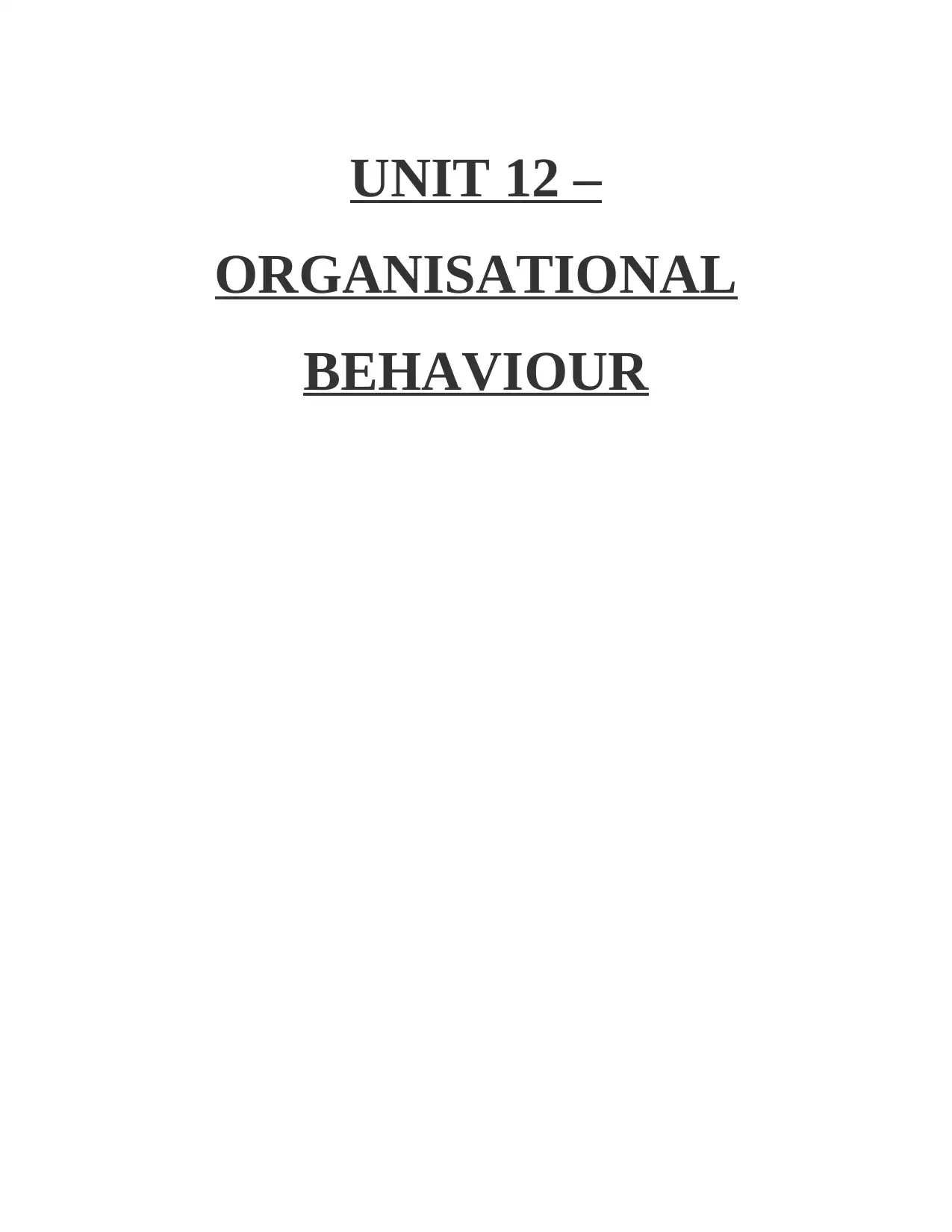
UNIT 12 –
ORGANISATIONAL
BEHAVIOUR
ORGANISATIONAL
BEHAVIOUR
Paraphrase This Document
Need a fresh take? Get an instant paraphrase of this document with our AI Paraphraser
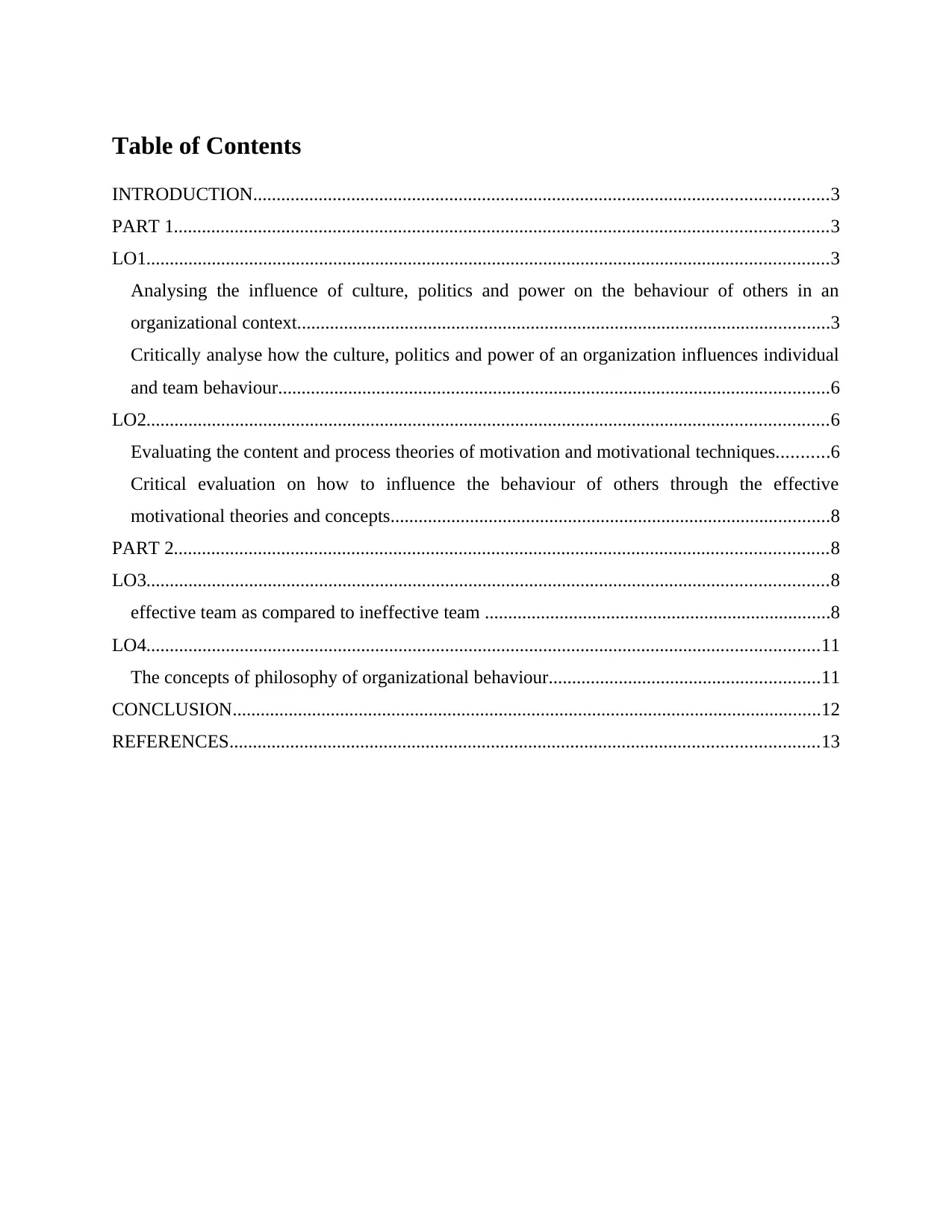
Table of Contents
INTRODUCTION...........................................................................................................................3
PART 1............................................................................................................................................3
LO1..................................................................................................................................................3
Analysing the influence of culture, politics and power on the behaviour of others in an
organizational context..................................................................................................................3
Critically analyse how the culture, politics and power of an organization influences individual
and team behaviour......................................................................................................................6
LO2..................................................................................................................................................6
Evaluating the content and process theories of motivation and motivational techniques...........6
Critical evaluation on how to influence the behaviour of others through the effective
motivational theories and concepts..............................................................................................8
PART 2............................................................................................................................................8
LO3..................................................................................................................................................8
effective team as compared to ineffective team ..........................................................................8
LO4................................................................................................................................................11
The concepts of philosophy of organizational behaviour..........................................................11
CONCLUSION..............................................................................................................................12
REFERENCES..............................................................................................................................13
INTRODUCTION...........................................................................................................................3
PART 1............................................................................................................................................3
LO1..................................................................................................................................................3
Analysing the influence of culture, politics and power on the behaviour of others in an
organizational context..................................................................................................................3
Critically analyse how the culture, politics and power of an organization influences individual
and team behaviour......................................................................................................................6
LO2..................................................................................................................................................6
Evaluating the content and process theories of motivation and motivational techniques...........6
Critical evaluation on how to influence the behaviour of others through the effective
motivational theories and concepts..............................................................................................8
PART 2............................................................................................................................................8
LO3..................................................................................................................................................8
effective team as compared to ineffective team ..........................................................................8
LO4................................................................................................................................................11
The concepts of philosophy of organizational behaviour..........................................................11
CONCLUSION..............................................................................................................................12
REFERENCES..............................................................................................................................13
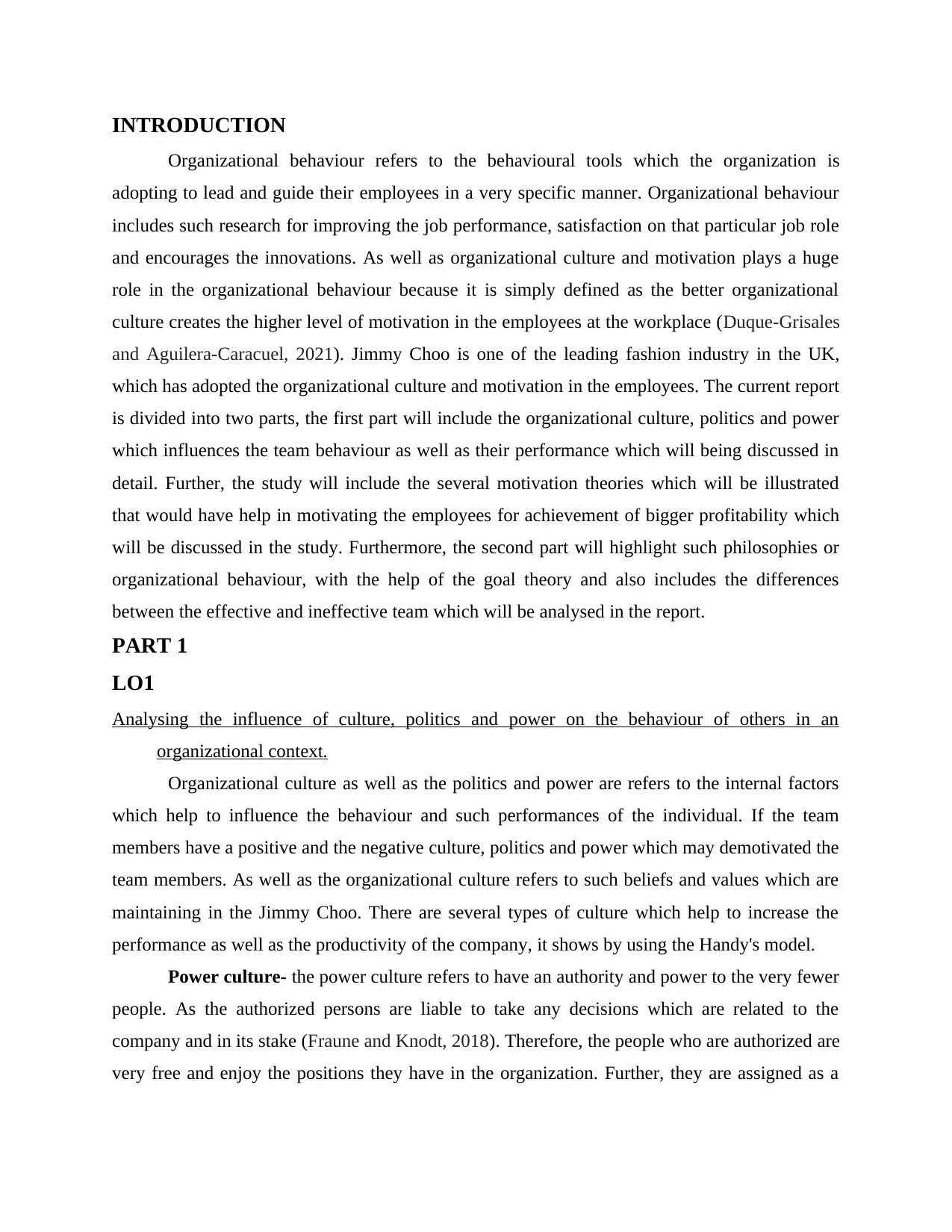
INTRODUCTION
Organizational behaviour refers to the behavioural tools which the organization is
adopting to lead and guide their employees in a very specific manner. Organizational behaviour
includes such research for improving the job performance, satisfaction on that particular job role
and encourages the innovations. As well as organizational culture and motivation plays a huge
role in the organizational behaviour because it is simply defined as the better organizational
culture creates the higher level of motivation in the employees at the workplace (Duque-Grisales
and Aguilera-Caracuel, 2021). Jimmy Choo is one of the leading fashion industry in the UK,
which has adopted the organizational culture and motivation in the employees. The current report
is divided into two parts, the first part will include the organizational culture, politics and power
which influences the team behaviour as well as their performance which will being discussed in
detail. Further, the study will include the several motivation theories which will be illustrated
that would have help in motivating the employees for achievement of bigger profitability which
will be discussed in the study. Furthermore, the second part will highlight such philosophies or
organizational behaviour, with the help of the goal theory and also includes the differences
between the effective and ineffective team which will be analysed in the report.
PART 1
LO1
Analysing the influence of culture, politics and power on the behaviour of others in an
organizational context.
Organizational culture as well as the politics and power are refers to the internal factors
which help to influence the behaviour and such performances of the individual. If the team
members have a positive and the negative culture, politics and power which may demotivated the
team members. As well as the organizational culture refers to such beliefs and values which are
maintaining in the Jimmy Choo. There are several types of culture which help to increase the
performance as well as the productivity of the company, it shows by using the Handy's model.
Power culture- the power culture refers to have an authority and power to the very fewer
people. As the authorized persons are liable to take any decisions which are related to the
company and in its stake (Fraune and Knodt, 2018). Therefore, the people who are authorized are
very free and enjoy the positions they have in the organization. Further, they are assigned as a
Organizational behaviour refers to the behavioural tools which the organization is
adopting to lead and guide their employees in a very specific manner. Organizational behaviour
includes such research for improving the job performance, satisfaction on that particular job role
and encourages the innovations. As well as organizational culture and motivation plays a huge
role in the organizational behaviour because it is simply defined as the better organizational
culture creates the higher level of motivation in the employees at the workplace (Duque-Grisales
and Aguilera-Caracuel, 2021). Jimmy Choo is one of the leading fashion industry in the UK,
which has adopted the organizational culture and motivation in the employees. The current report
is divided into two parts, the first part will include the organizational culture, politics and power
which influences the team behaviour as well as their performance which will being discussed in
detail. Further, the study will include the several motivation theories which will be illustrated
that would have help in motivating the employees for achievement of bigger profitability which
will be discussed in the study. Furthermore, the second part will highlight such philosophies or
organizational behaviour, with the help of the goal theory and also includes the differences
between the effective and ineffective team which will be analysed in the report.
PART 1
LO1
Analysing the influence of culture, politics and power on the behaviour of others in an
organizational context.
Organizational culture as well as the politics and power are refers to the internal factors
which help to influence the behaviour and such performances of the individual. If the team
members have a positive and the negative culture, politics and power which may demotivated the
team members. As well as the organizational culture refers to such beliefs and values which are
maintaining in the Jimmy Choo. There are several types of culture which help to increase the
performance as well as the productivity of the company, it shows by using the Handy's model.
Power culture- the power culture refers to have an authority and power to the very fewer
people. As the authorized persons are liable to take any decisions which are related to the
company and in its stake (Fraune and Knodt, 2018). Therefore, the people who are authorized are
very free and enjoy the positions they have in the organization. Further, they are assigned as a
⊘ This is a preview!⊘
Do you want full access?
Subscribe today to unlock all pages.

Trusted by 1+ million students worldwide
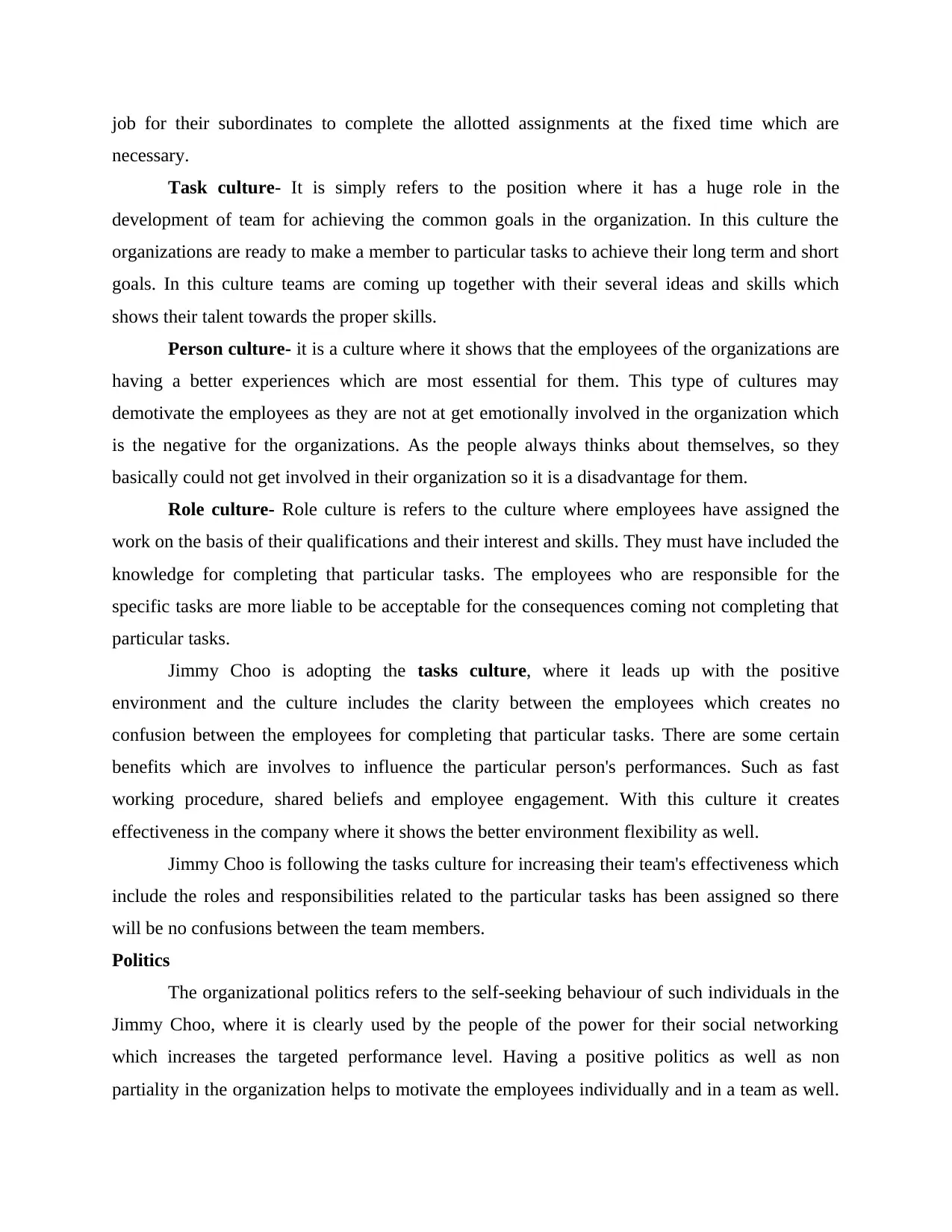
job for their subordinates to complete the allotted assignments at the fixed time which are
necessary.
Task culture- It is simply refers to the position where it has a huge role in the
development of team for achieving the common goals in the organization. In this culture the
organizations are ready to make a member to particular tasks to achieve their long term and short
goals. In this culture teams are coming up together with their several ideas and skills which
shows their talent towards the proper skills.
Person culture- it is a culture where it shows that the employees of the organizations are
having a better experiences which are most essential for them. This type of cultures may
demotivate the employees as they are not at get emotionally involved in the organization which
is the negative for the organizations. As the people always thinks about themselves, so they
basically could not get involved in their organization so it is a disadvantage for them.
Role culture- Role culture is refers to the culture where employees have assigned the
work on the basis of their qualifications and their interest and skills. They must have included the
knowledge for completing that particular tasks. The employees who are responsible for the
specific tasks are more liable to be acceptable for the consequences coming not completing that
particular tasks.
Jimmy Choo is adopting the tasks culture, where it leads up with the positive
environment and the culture includes the clarity between the employees which creates no
confusion between the employees for completing that particular tasks. There are some certain
benefits which are involves to influence the particular person's performances. Such as fast
working procedure, shared beliefs and employee engagement. With this culture it creates
effectiveness in the company where it shows the better environment flexibility as well.
Jimmy Choo is following the tasks culture for increasing their team's effectiveness which
include the roles and responsibilities related to the particular tasks has been assigned so there
will be no confusions between the team members.
Politics
The organizational politics refers to the self-seeking behaviour of such individuals in the
Jimmy Choo, where it is clearly used by the people of the power for their social networking
which increases the targeted performance level. Having a positive politics as well as non
partiality in the organization helps to motivate the employees individually and in a team as well.
necessary.
Task culture- It is simply refers to the position where it has a huge role in the
development of team for achieving the common goals in the organization. In this culture the
organizations are ready to make a member to particular tasks to achieve their long term and short
goals. In this culture teams are coming up together with their several ideas and skills which
shows their talent towards the proper skills.
Person culture- it is a culture where it shows that the employees of the organizations are
having a better experiences which are most essential for them. This type of cultures may
demotivate the employees as they are not at get emotionally involved in the organization which
is the negative for the organizations. As the people always thinks about themselves, so they
basically could not get involved in their organization so it is a disadvantage for them.
Role culture- Role culture is refers to the culture where employees have assigned the
work on the basis of their qualifications and their interest and skills. They must have included the
knowledge for completing that particular tasks. The employees who are responsible for the
specific tasks are more liable to be acceptable for the consequences coming not completing that
particular tasks.
Jimmy Choo is adopting the tasks culture, where it leads up with the positive
environment and the culture includes the clarity between the employees which creates no
confusion between the employees for completing that particular tasks. There are some certain
benefits which are involves to influence the particular person's performances. Such as fast
working procedure, shared beliefs and employee engagement. With this culture it creates
effectiveness in the company where it shows the better environment flexibility as well.
Jimmy Choo is following the tasks culture for increasing their team's effectiveness which
include the roles and responsibilities related to the particular tasks has been assigned so there
will be no confusions between the team members.
Politics
The organizational politics refers to the self-seeking behaviour of such individuals in the
Jimmy Choo, where it is clearly used by the people of the power for their social networking
which increases the targeted performance level. Having a positive politics as well as non
partiality in the organization helps to motivate the employees individually and in a team as well.
Paraphrase This Document
Need a fresh take? Get an instant paraphrase of this document with our AI Paraphraser
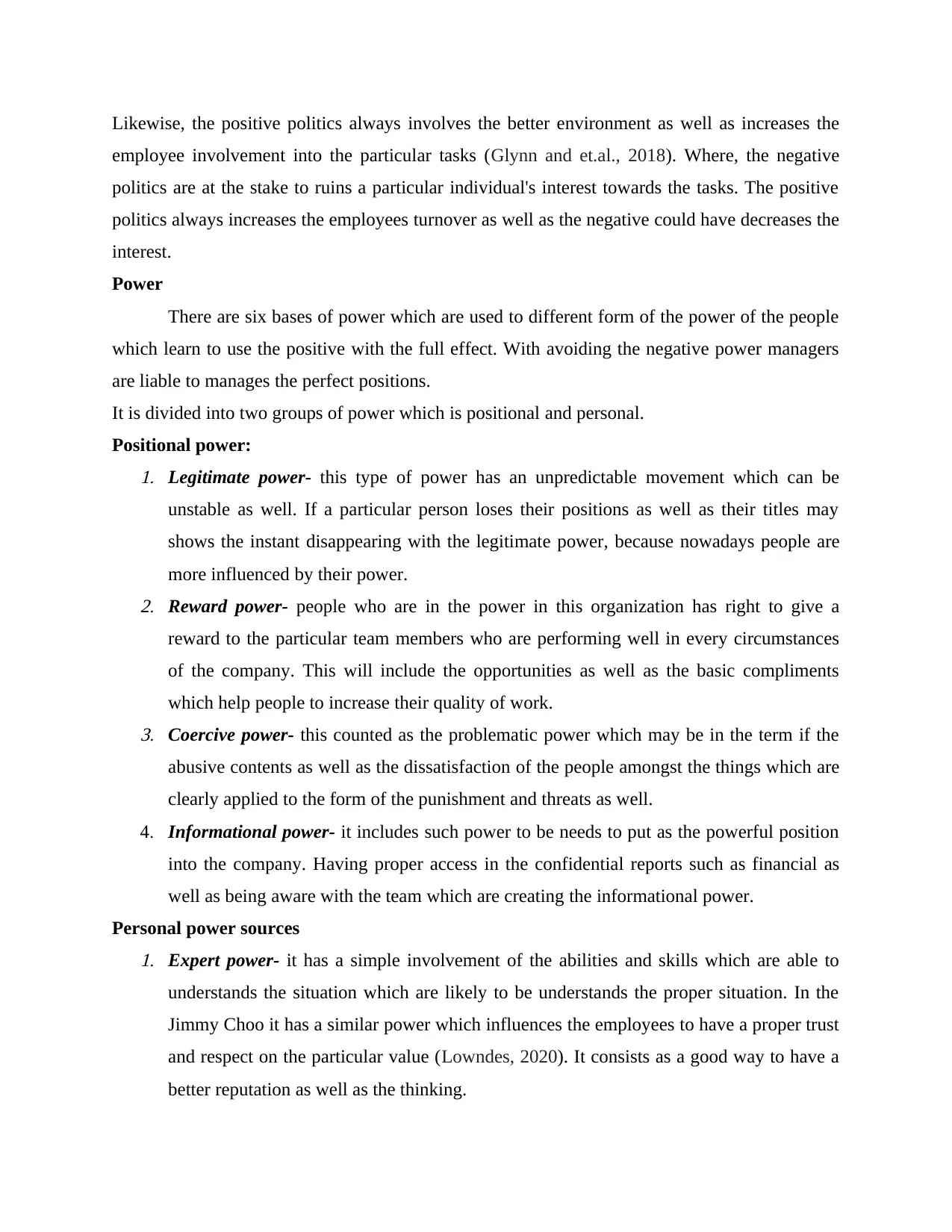
Likewise, the positive politics always involves the better environment as well as increases the
employee involvement into the particular tasks (Glynn and et.al., 2018). Where, the negative
politics are at the stake to ruins a particular individual's interest towards the tasks. The positive
politics always increases the employees turnover as well as the negative could have decreases the
interest.
Power
There are six bases of power which are used to different form of the power of the people
which learn to use the positive with the full effect. With avoiding the negative power managers
are liable to manages the perfect positions.
It is divided into two groups of power which is positional and personal.
Positional power:1. Legitimate power- this type of power has an unpredictable movement which can be
unstable as well. If a particular person loses their positions as well as their titles may
shows the instant disappearing with the legitimate power, because nowadays people are
more influenced by their power.2. Reward power- people who are in the power in this organization has right to give a
reward to the particular team members who are performing well in every circumstances
of the company. This will include the opportunities as well as the basic compliments
which help people to increase their quality of work.3. Coercive power- this counted as the problematic power which may be in the term if the
abusive contents as well as the dissatisfaction of the people amongst the things which are
clearly applied to the form of the punishment and threats as well.
4. Informational power- it includes such power to be needs to put as the powerful position
into the company. Having proper access in the confidential reports such as financial as
well as being aware with the team which are creating the informational power.
Personal power sources1. Expert power- it has a simple involvement of the abilities and skills which are able to
understands the situation which are likely to be understands the proper situation. In the
Jimmy Choo it has a similar power which influences the employees to have a proper trust
and respect on the particular value (Lowndes, 2020). It consists as a good way to have a
better reputation as well as the thinking.
employee involvement into the particular tasks (Glynn and et.al., 2018). Where, the negative
politics are at the stake to ruins a particular individual's interest towards the tasks. The positive
politics always increases the employees turnover as well as the negative could have decreases the
interest.
Power
There are six bases of power which are used to different form of the power of the people
which learn to use the positive with the full effect. With avoiding the negative power managers
are liable to manages the perfect positions.
It is divided into two groups of power which is positional and personal.
Positional power:1. Legitimate power- this type of power has an unpredictable movement which can be
unstable as well. If a particular person loses their positions as well as their titles may
shows the instant disappearing with the legitimate power, because nowadays people are
more influenced by their power.2. Reward power- people who are in the power in this organization has right to give a
reward to the particular team members who are performing well in every circumstances
of the company. This will include the opportunities as well as the basic compliments
which help people to increase their quality of work.3. Coercive power- this counted as the problematic power which may be in the term if the
abusive contents as well as the dissatisfaction of the people amongst the things which are
clearly applied to the form of the punishment and threats as well.
4. Informational power- it includes such power to be needs to put as the powerful position
into the company. Having proper access in the confidential reports such as financial as
well as being aware with the team which are creating the informational power.
Personal power sources1. Expert power- it has a simple involvement of the abilities and skills which are able to
understands the situation which are likely to be understands the proper situation. In the
Jimmy Choo it has a similar power which influences the employees to have a proper trust
and respect on the particular value (Lowndes, 2020). It consists as a good way to have a
better reputation as well as the thinking.
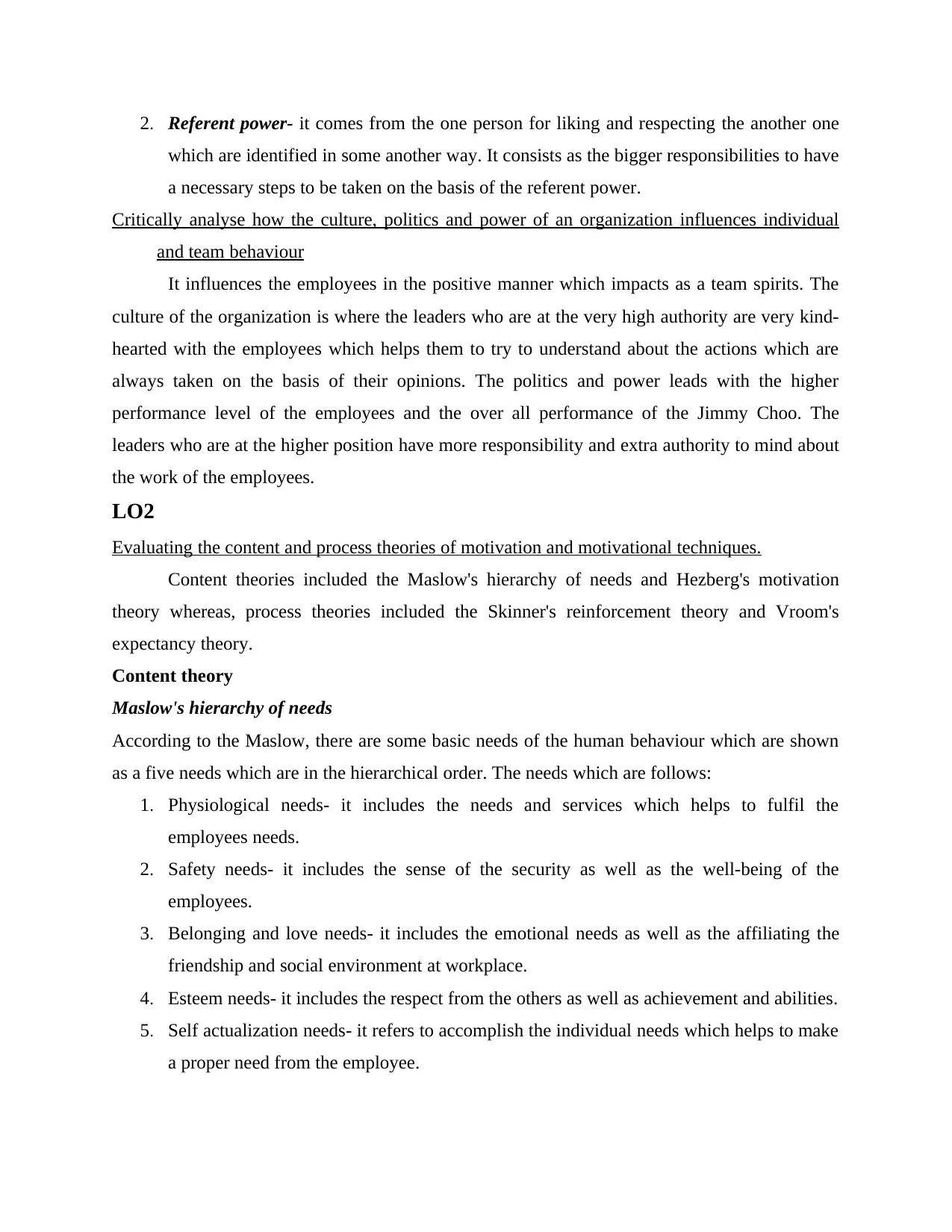
2. Referent power- it comes from the one person for liking and respecting the another one
which are identified in some another way. It consists as the bigger responsibilities to have
a necessary steps to be taken on the basis of the referent power.
Critically analyse how the culture, politics and power of an organization influences individual
and team behaviour
It influences the employees in the positive manner which impacts as a team spirits. The
culture of the organization is where the leaders who are at the very high authority are very kind-
hearted with the employees which helps them to try to understand about the actions which are
always taken on the basis of their opinions. The politics and power leads with the higher
performance level of the employees and the over all performance of the Jimmy Choo. The
leaders who are at the higher position have more responsibility and extra authority to mind about
the work of the employees.
LO2
Evaluating the content and process theories of motivation and motivational techniques.
Content theories included the Maslow's hierarchy of needs and Hezberg's motivation
theory whereas, process theories included the Skinner's reinforcement theory and Vroom's
expectancy theory.
Content theory
Maslow's hierarchy of needs
According to the Maslow, there are some basic needs of the human behaviour which are shown
as a five needs which are in the hierarchical order. The needs which are follows:
1. Physiological needs- it includes the needs and services which helps to fulfil the
employees needs.
2. Safety needs- it includes the sense of the security as well as the well-being of the
employees.
3. Belonging and love needs- it includes the emotional needs as well as the affiliating the
friendship and social environment at workplace.
4. Esteem needs- it includes the respect from the others as well as achievement and abilities.
5. Self actualization needs- it refers to accomplish the individual needs which helps to make
a proper need from the employee.
which are identified in some another way. It consists as the bigger responsibilities to have
a necessary steps to be taken on the basis of the referent power.
Critically analyse how the culture, politics and power of an organization influences individual
and team behaviour
It influences the employees in the positive manner which impacts as a team spirits. The
culture of the organization is where the leaders who are at the very high authority are very kind-
hearted with the employees which helps them to try to understand about the actions which are
always taken on the basis of their opinions. The politics and power leads with the higher
performance level of the employees and the over all performance of the Jimmy Choo. The
leaders who are at the higher position have more responsibility and extra authority to mind about
the work of the employees.
LO2
Evaluating the content and process theories of motivation and motivational techniques.
Content theories included the Maslow's hierarchy of needs and Hezberg's motivation
theory whereas, process theories included the Skinner's reinforcement theory and Vroom's
expectancy theory.
Content theory
Maslow's hierarchy of needs
According to the Maslow, there are some basic needs of the human behaviour which are shown
as a five needs which are in the hierarchical order. The needs which are follows:
1. Physiological needs- it includes the needs and services which helps to fulfil the
employees needs.
2. Safety needs- it includes the sense of the security as well as the well-being of the
employees.
3. Belonging and love needs- it includes the emotional needs as well as the affiliating the
friendship and social environment at workplace.
4. Esteem needs- it includes the respect from the others as well as achievement and abilities.
5. Self actualization needs- it refers to accomplish the individual needs which helps to make
a proper need from the employee.
⊘ This is a preview!⊘
Do you want full access?
Subscribe today to unlock all pages.

Trusted by 1+ million students worldwide
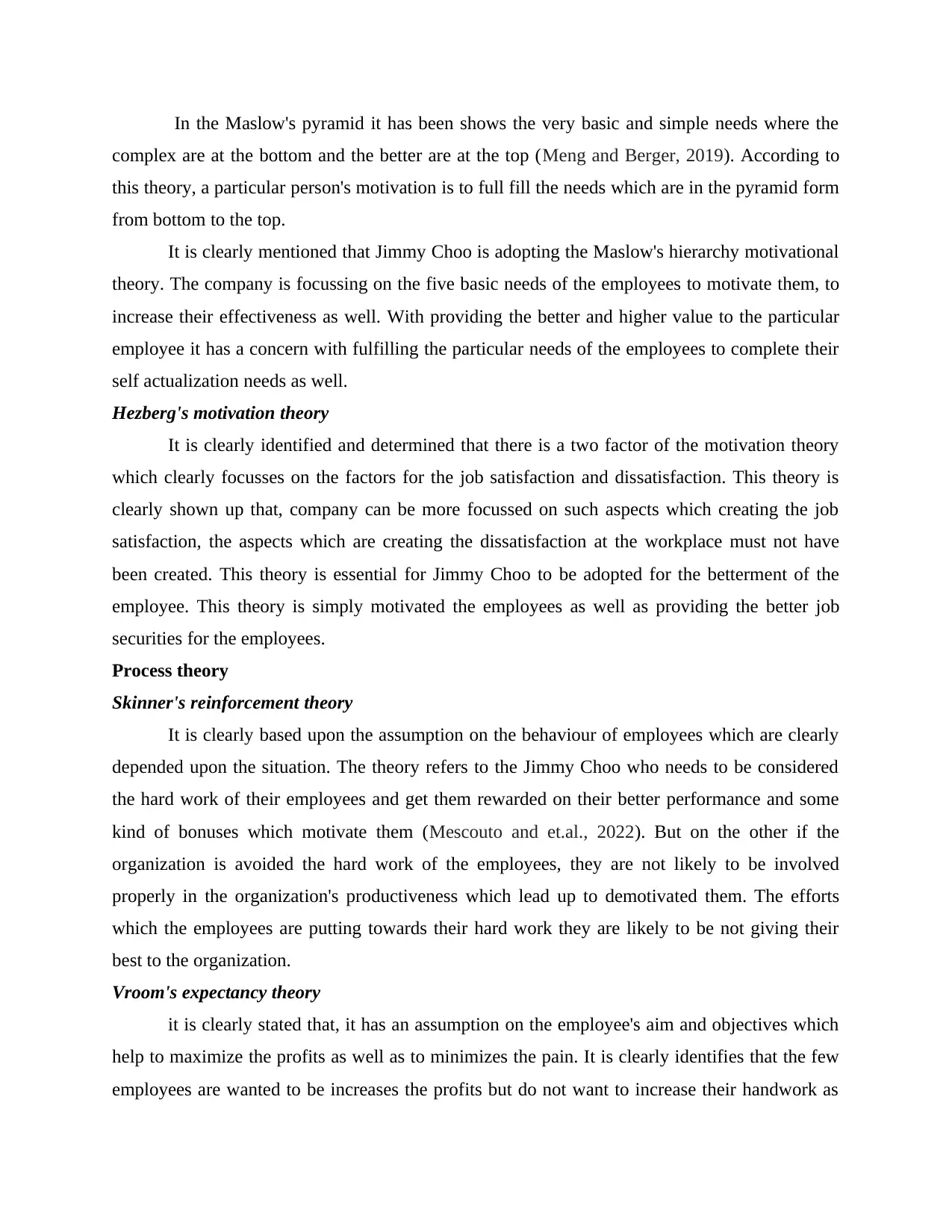
In the Maslow's pyramid it has been shows the very basic and simple needs where the
complex are at the bottom and the better are at the top (Meng and Berger, 2019). According to
this theory, a particular person's motivation is to full fill the needs which are in the pyramid form
from bottom to the top.
It is clearly mentioned that Jimmy Choo is adopting the Maslow's hierarchy motivational
theory. The company is focussing on the five basic needs of the employees to motivate them, to
increase their effectiveness as well. With providing the better and higher value to the particular
employee it has a concern with fulfilling the particular needs of the employees to complete their
self actualization needs as well.
Hezberg's motivation theory
It is clearly identified and determined that there is a two factor of the motivation theory
which clearly focusses on the factors for the job satisfaction and dissatisfaction. This theory is
clearly shown up that, company can be more focussed on such aspects which creating the job
satisfaction, the aspects which are creating the dissatisfaction at the workplace must not have
been created. This theory is essential for Jimmy Choo to be adopted for the betterment of the
employee. This theory is simply motivated the employees as well as providing the better job
securities for the employees.
Process theory
Skinner's reinforcement theory
It is clearly based upon the assumption on the behaviour of employees which are clearly
depended upon the situation. The theory refers to the Jimmy Choo who needs to be considered
the hard work of their employees and get them rewarded on their better performance and some
kind of bonuses which motivate them (Mescouto and et.al., 2022). But on the other if the
organization is avoided the hard work of the employees, they are not likely to be involved
properly in the organization's productiveness which lead up to demotivated them. The efforts
which the employees are putting towards their hard work they are likely to be not giving their
best to the organization.
Vroom's expectancy theory
it is clearly stated that, it has an assumption on the employee's aim and objectives which
help to maximize the profits as well as to minimizes the pain. It is clearly identifies that the few
employees are wanted to be increases the profits but do not want to increase their handwork as
complex are at the bottom and the better are at the top (Meng and Berger, 2019). According to
this theory, a particular person's motivation is to full fill the needs which are in the pyramid form
from bottom to the top.
It is clearly mentioned that Jimmy Choo is adopting the Maslow's hierarchy motivational
theory. The company is focussing on the five basic needs of the employees to motivate them, to
increase their effectiveness as well. With providing the better and higher value to the particular
employee it has a concern with fulfilling the particular needs of the employees to complete their
self actualization needs as well.
Hezberg's motivation theory
It is clearly identified and determined that there is a two factor of the motivation theory
which clearly focusses on the factors for the job satisfaction and dissatisfaction. This theory is
clearly shown up that, company can be more focussed on such aspects which creating the job
satisfaction, the aspects which are creating the dissatisfaction at the workplace must not have
been created. This theory is essential for Jimmy Choo to be adopted for the betterment of the
employee. This theory is simply motivated the employees as well as providing the better job
securities for the employees.
Process theory
Skinner's reinforcement theory
It is clearly based upon the assumption on the behaviour of employees which are clearly
depended upon the situation. The theory refers to the Jimmy Choo who needs to be considered
the hard work of their employees and get them rewarded on their better performance and some
kind of bonuses which motivate them (Mescouto and et.al., 2022). But on the other if the
organization is avoided the hard work of the employees, they are not likely to be involved
properly in the organization's productiveness which lead up to demotivated them. The efforts
which the employees are putting towards their hard work they are likely to be not giving their
best to the organization.
Vroom's expectancy theory
it is clearly stated that, it has an assumption on the employee's aim and objectives which
help to maximize the profits as well as to minimizes the pain. It is clearly identifies that the few
employees are wanted to be increases the profits but do not want to increase their handwork as
Paraphrase This Document
Need a fresh take? Get an instant paraphrase of this document with our AI Paraphraser
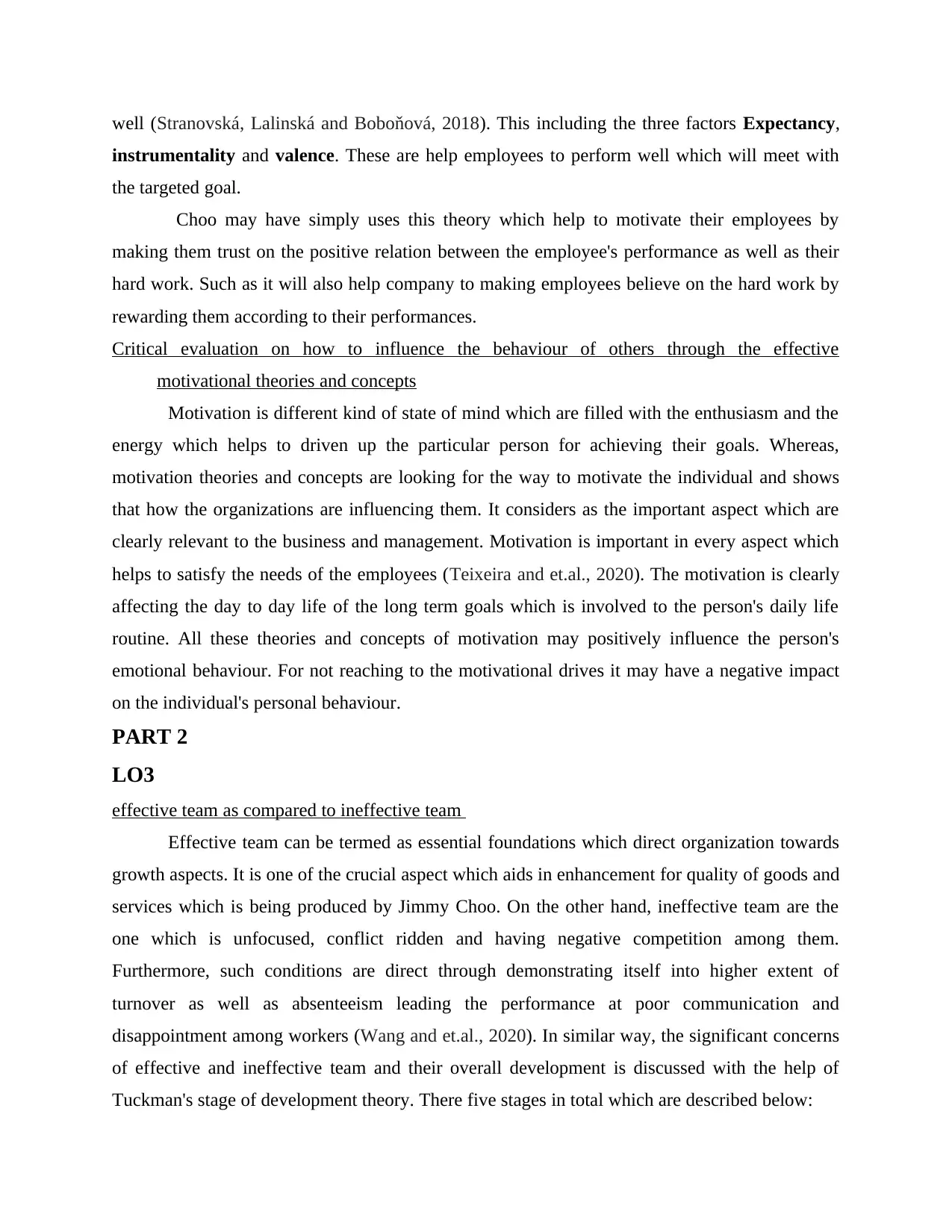
well (Stranovská, Lalinská and Boboňová, 2018). This including the three factors Expectancy,
instrumentality and valence. These are help employees to perform well which will meet with
the targeted goal.
Choo may have simply uses this theory which help to motivate their employees by
making them trust on the positive relation between the employee's performance as well as their
hard work. Such as it will also help company to making employees believe on the hard work by
rewarding them according to their performances.
Critical evaluation on how to influence the behaviour of others through the effective
motivational theories and concepts
Motivation is different kind of state of mind which are filled with the enthusiasm and the
energy which helps to driven up the particular person for achieving their goals. Whereas,
motivation theories and concepts are looking for the way to motivate the individual and shows
that how the organizations are influencing them. It considers as the important aspect which are
clearly relevant to the business and management. Motivation is important in every aspect which
helps to satisfy the needs of the employees (Teixeira and et.al., 2020). The motivation is clearly
affecting the day to day life of the long term goals which is involved to the person's daily life
routine. All these theories and concepts of motivation may positively influence the person's
emotional behaviour. For not reaching to the motivational drives it may have a negative impact
on the individual's personal behaviour.
PART 2
LO3
effective team as compared to ineffective team
Effective team can be termed as essential foundations which direct organization towards
growth aspects. It is one of the crucial aspect which aids in enhancement for quality of goods and
services which is being produced by Jimmy Choo. On the other hand, ineffective team are the
one which is unfocused, conflict ridden and having negative competition among them.
Furthermore, such conditions are direct through demonstrating itself into higher extent of
turnover as well as absenteeism leading the performance at poor communication and
disappointment among workers (Wang and et.al., 2020). In similar way, the significant concerns
of effective and ineffective team and their overall development is discussed with the help of
Tuckman's stage of development theory. There five stages in total which are described below:
instrumentality and valence. These are help employees to perform well which will meet with
the targeted goal.
Choo may have simply uses this theory which help to motivate their employees by
making them trust on the positive relation between the employee's performance as well as their
hard work. Such as it will also help company to making employees believe on the hard work by
rewarding them according to their performances.
Critical evaluation on how to influence the behaviour of others through the effective
motivational theories and concepts
Motivation is different kind of state of mind which are filled with the enthusiasm and the
energy which helps to driven up the particular person for achieving their goals. Whereas,
motivation theories and concepts are looking for the way to motivate the individual and shows
that how the organizations are influencing them. It considers as the important aspect which are
clearly relevant to the business and management. Motivation is important in every aspect which
helps to satisfy the needs of the employees (Teixeira and et.al., 2020). The motivation is clearly
affecting the day to day life of the long term goals which is involved to the person's daily life
routine. All these theories and concepts of motivation may positively influence the person's
emotional behaviour. For not reaching to the motivational drives it may have a negative impact
on the individual's personal behaviour.
PART 2
LO3
effective team as compared to ineffective team
Effective team can be termed as essential foundations which direct organization towards
growth aspects. It is one of the crucial aspect which aids in enhancement for quality of goods and
services which is being produced by Jimmy Choo. On the other hand, ineffective team are the
one which is unfocused, conflict ridden and having negative competition among them.
Furthermore, such conditions are direct through demonstrating itself into higher extent of
turnover as well as absenteeism leading the performance at poor communication and
disappointment among workers (Wang and et.al., 2020). In similar way, the significant concerns
of effective and ineffective team and their overall development is discussed with the help of
Tuckman's stage of development theory. There five stages in total which are described below:
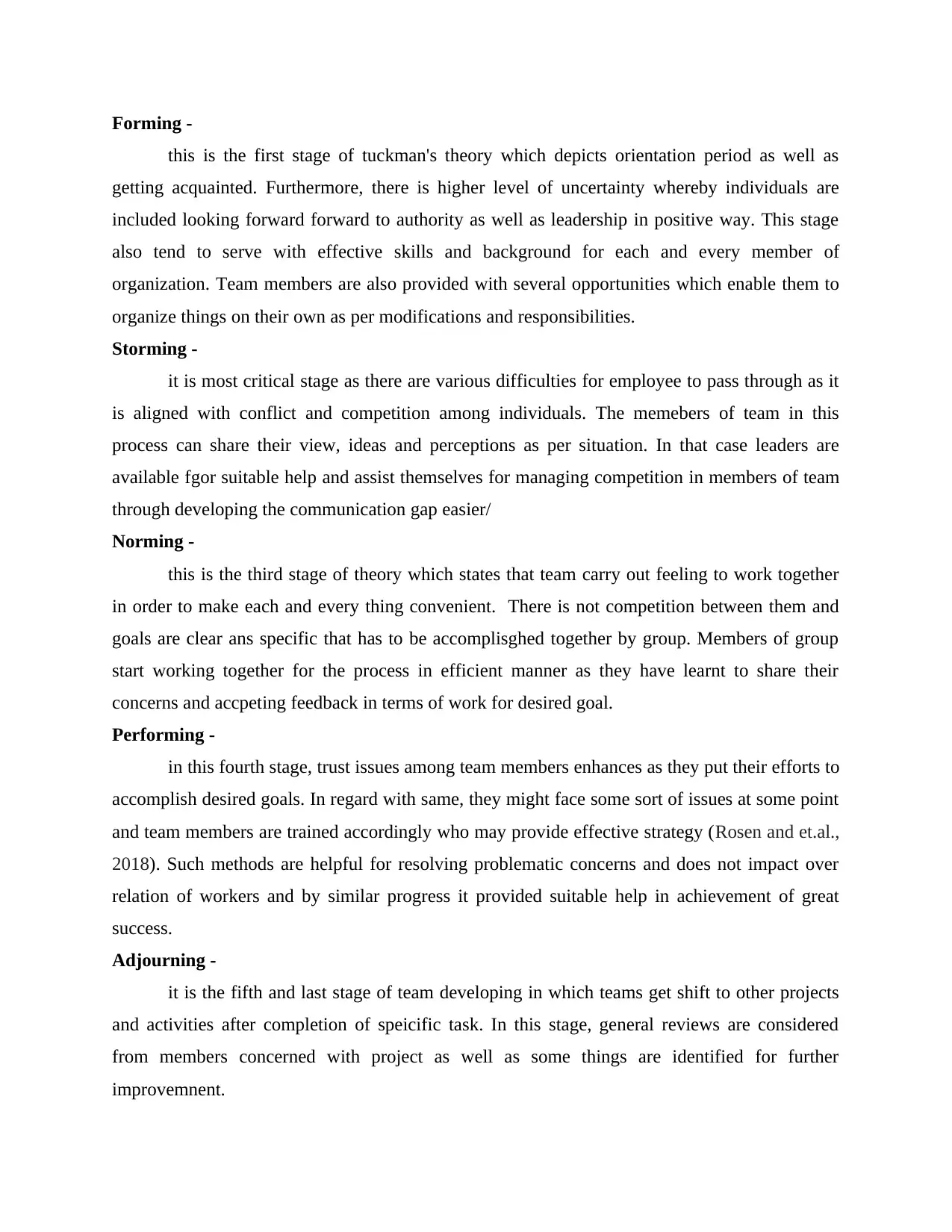
Forming -
this is the first stage of tuckman's theory which depicts orientation period as well as
getting acquainted. Furthermore, there is higher level of uncertainty whereby individuals are
included looking forward forward to authority as well as leadership in positive way. This stage
also tend to serve with effective skills and background for each and every member of
organization. Team members are also provided with several opportunities which enable them to
organize things on their own as per modifications and responsibilities.
Storming -
it is most critical stage as there are various difficulties for employee to pass through as it
is aligned with conflict and competition among individuals. The memebers of team in this
process can share their view, ideas and perceptions as per situation. In that case leaders are
available fgor suitable help and assist themselves for managing competition in members of team
through developing the communication gap easier/
Norming -
this is the third stage of theory which states that team carry out feeling to work together
in order to make each and every thing convenient. There is not competition between them and
goals are clear ans specific that has to be accomplisghed together by group. Members of group
start working together for the process in efficient manner as they have learnt to share their
concerns and accpeting feedback in terms of work for desired goal.
Performing -
in this fourth stage, trust issues among team members enhances as they put their efforts to
accomplish desired goals. In regard with same, they might face some sort of issues at some point
and team members are trained accordingly who may provide effective strategy (Rosen and et.al.,
2018). Such methods are helpful for resolving problematic concerns and does not impact over
relation of workers and by similar progress it provided suitable help in achievement of great
success.
Adjourning -
it is the fifth and last stage of team developing in which teams get shift to other projects
and activities after completion of speicific task. In this stage, general reviews are considered
from members concerned with project as well as some things are identified for further
improvemnent.
this is the first stage of tuckman's theory which depicts orientation period as well as
getting acquainted. Furthermore, there is higher level of uncertainty whereby individuals are
included looking forward forward to authority as well as leadership in positive way. This stage
also tend to serve with effective skills and background for each and every member of
organization. Team members are also provided with several opportunities which enable them to
organize things on their own as per modifications and responsibilities.
Storming -
it is most critical stage as there are various difficulties for employee to pass through as it
is aligned with conflict and competition among individuals. The memebers of team in this
process can share their view, ideas and perceptions as per situation. In that case leaders are
available fgor suitable help and assist themselves for managing competition in members of team
through developing the communication gap easier/
Norming -
this is the third stage of theory which states that team carry out feeling to work together
in order to make each and every thing convenient. There is not competition between them and
goals are clear ans specific that has to be accomplisghed together by group. Members of group
start working together for the process in efficient manner as they have learnt to share their
concerns and accpeting feedback in terms of work for desired goal.
Performing -
in this fourth stage, trust issues among team members enhances as they put their efforts to
accomplish desired goals. In regard with same, they might face some sort of issues at some point
and team members are trained accordingly who may provide effective strategy (Rosen and et.al.,
2018). Such methods are helpful for resolving problematic concerns and does not impact over
relation of workers and by similar progress it provided suitable help in achievement of great
success.
Adjourning -
it is the fifth and last stage of team developing in which teams get shift to other projects
and activities after completion of speicific task. In this stage, general reviews are considered
from members concerned with project as well as some things are identified for further
improvemnent.
⊘ This is a preview!⊘
Do you want full access?
Subscribe today to unlock all pages.

Trusted by 1+ million students worldwide
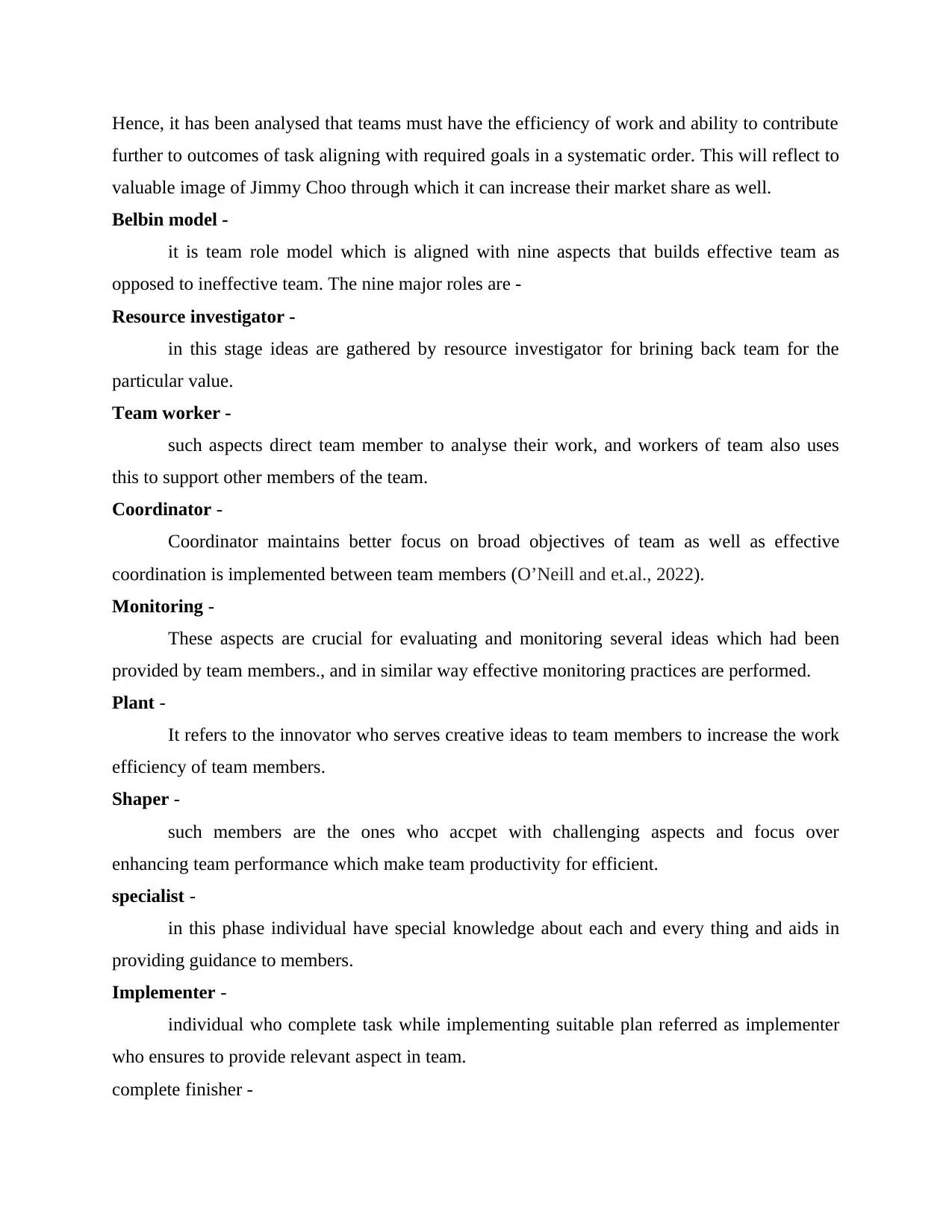
Hence, it has been analysed that teams must have the efficiency of work and ability to contribute
further to outcomes of task aligning with required goals in a systematic order. This will reflect to
valuable image of Jimmy Choo through which it can increase their market share as well.
Belbin model -
it is team role model which is aligned with nine aspects that builds effective team as
opposed to ineffective team. The nine major roles are -
Resource investigator -
in this stage ideas are gathered by resource investigator for brining back team for the
particular value.
Team worker -
such aspects direct team member to analyse their work, and workers of team also uses
this to support other members of the team.
Coordinator -
Coordinator maintains better focus on broad objectives of team as well as effective
coordination is implemented between team members (O’Neill and et.al., 2022).
Monitoring -
These aspects are crucial for evaluating and monitoring several ideas which had been
provided by team members., and in similar way effective monitoring practices are performed.
Plant -
It refers to the innovator who serves creative ideas to team members to increase the work
efficiency of team members.
Shaper -
such members are the ones who accpet with challenging aspects and focus over
enhancing team performance which make team productivity for efficient.
specialist -
in this phase individual have special knowledge about each and every thing and aids in
providing guidance to members.
Implementer -
individual who complete task while implementing suitable plan referred as implementer
who ensures to provide relevant aspect in team.
complete finisher -
further to outcomes of task aligning with required goals in a systematic order. This will reflect to
valuable image of Jimmy Choo through which it can increase their market share as well.
Belbin model -
it is team role model which is aligned with nine aspects that builds effective team as
opposed to ineffective team. The nine major roles are -
Resource investigator -
in this stage ideas are gathered by resource investigator for brining back team for the
particular value.
Team worker -
such aspects direct team member to analyse their work, and workers of team also uses
this to support other members of the team.
Coordinator -
Coordinator maintains better focus on broad objectives of team as well as effective
coordination is implemented between team members (O’Neill and et.al., 2022).
Monitoring -
These aspects are crucial for evaluating and monitoring several ideas which had been
provided by team members., and in similar way effective monitoring practices are performed.
Plant -
It refers to the innovator who serves creative ideas to team members to increase the work
efficiency of team members.
Shaper -
such members are the ones who accpet with challenging aspects and focus over
enhancing team performance which make team productivity for efficient.
specialist -
in this phase individual have special knowledge about each and every thing and aids in
providing guidance to members.
Implementer -
individual who complete task while implementing suitable plan referred as implementer
who ensures to provide relevant aspect in team.
complete finisher -
Paraphrase This Document
Need a fresh take? Get an instant paraphrase of this document with our AI Paraphraser
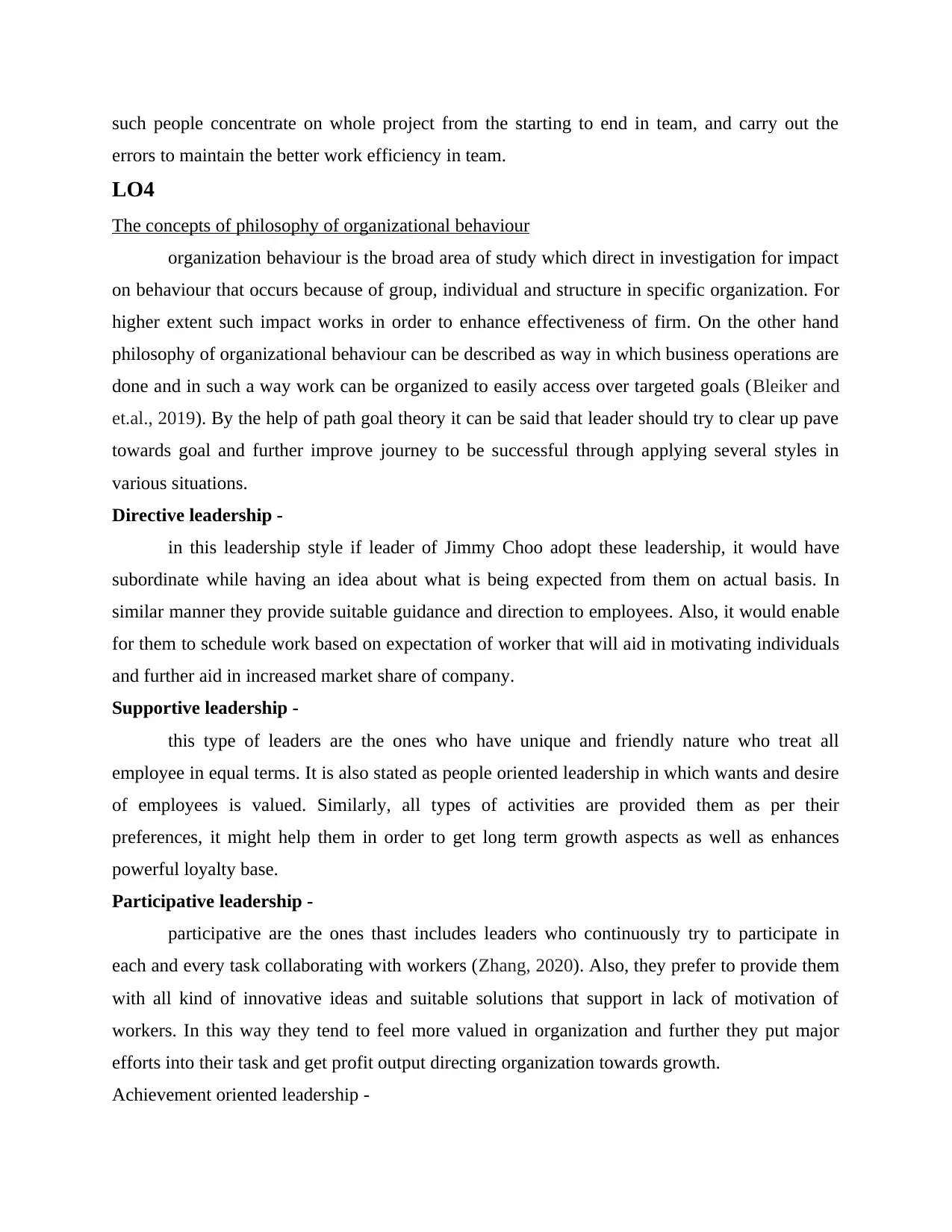
such people concentrate on whole project from the starting to end in team, and carry out the
errors to maintain the better work efficiency in team.
LO4
The concepts of philosophy of organizational behaviour
organization behaviour is the broad area of study which direct in investigation for impact
on behaviour that occurs because of group, individual and structure in specific organization. For
higher extent such impact works in order to enhance effectiveness of firm. On the other hand
philosophy of organizational behaviour can be described as way in which business operations are
done and in such a way work can be organized to easily access over targeted goals (Bleiker and
et.al., 2019). By the help of path goal theory it can be said that leader should try to clear up pave
towards goal and further improve journey to be successful through applying several styles in
various situations.
Directive leadership -
in this leadership style if leader of Jimmy Choo adopt these leadership, it would have
subordinate while having an idea about what is being expected from them on actual basis. In
similar manner they provide suitable guidance and direction to employees. Also, it would enable
for them to schedule work based on expectation of worker that will aid in motivating individuals
and further aid in increased market share of company.
Supportive leadership -
this type of leaders are the ones who have unique and friendly nature who treat all
employee in equal terms. It is also stated as people oriented leadership in which wants and desire
of employees is valued. Similarly, all types of activities are provided them as per their
preferences, it might help them in order to get long term growth aspects as well as enhances
powerful loyalty base.
Participative leadership -
participative are the ones thast includes leaders who continuously try to participate in
each and every task collaborating with workers (Zhang, 2020). Also, they prefer to provide them
with all kind of innovative ideas and suitable solutions that support in lack of motivation of
workers. In this way they tend to feel more valued in organization and further they put major
efforts into their task and get profit output directing organization towards growth.
Achievement oriented leadership -
errors to maintain the better work efficiency in team.
LO4
The concepts of philosophy of organizational behaviour
organization behaviour is the broad area of study which direct in investigation for impact
on behaviour that occurs because of group, individual and structure in specific organization. For
higher extent such impact works in order to enhance effectiveness of firm. On the other hand
philosophy of organizational behaviour can be described as way in which business operations are
done and in such a way work can be organized to easily access over targeted goals (Bleiker and
et.al., 2019). By the help of path goal theory it can be said that leader should try to clear up pave
towards goal and further improve journey to be successful through applying several styles in
various situations.
Directive leadership -
in this leadership style if leader of Jimmy Choo adopt these leadership, it would have
subordinate while having an idea about what is being expected from them on actual basis. In
similar manner they provide suitable guidance and direction to employees. Also, it would enable
for them to schedule work based on expectation of worker that will aid in motivating individuals
and further aid in increased market share of company.
Supportive leadership -
this type of leaders are the ones who have unique and friendly nature who treat all
employee in equal terms. It is also stated as people oriented leadership in which wants and desire
of employees is valued. Similarly, all types of activities are provided them as per their
preferences, it might help them in order to get long term growth aspects as well as enhances
powerful loyalty base.
Participative leadership -
participative are the ones thast includes leaders who continuously try to participate in
each and every task collaborating with workers (Zhang, 2020). Also, they prefer to provide them
with all kind of innovative ideas and suitable solutions that support in lack of motivation of
workers. In this way they tend to feel more valued in organization and further they put major
efforts into their task and get profit output directing organization towards growth.
Achievement oriented leadership -
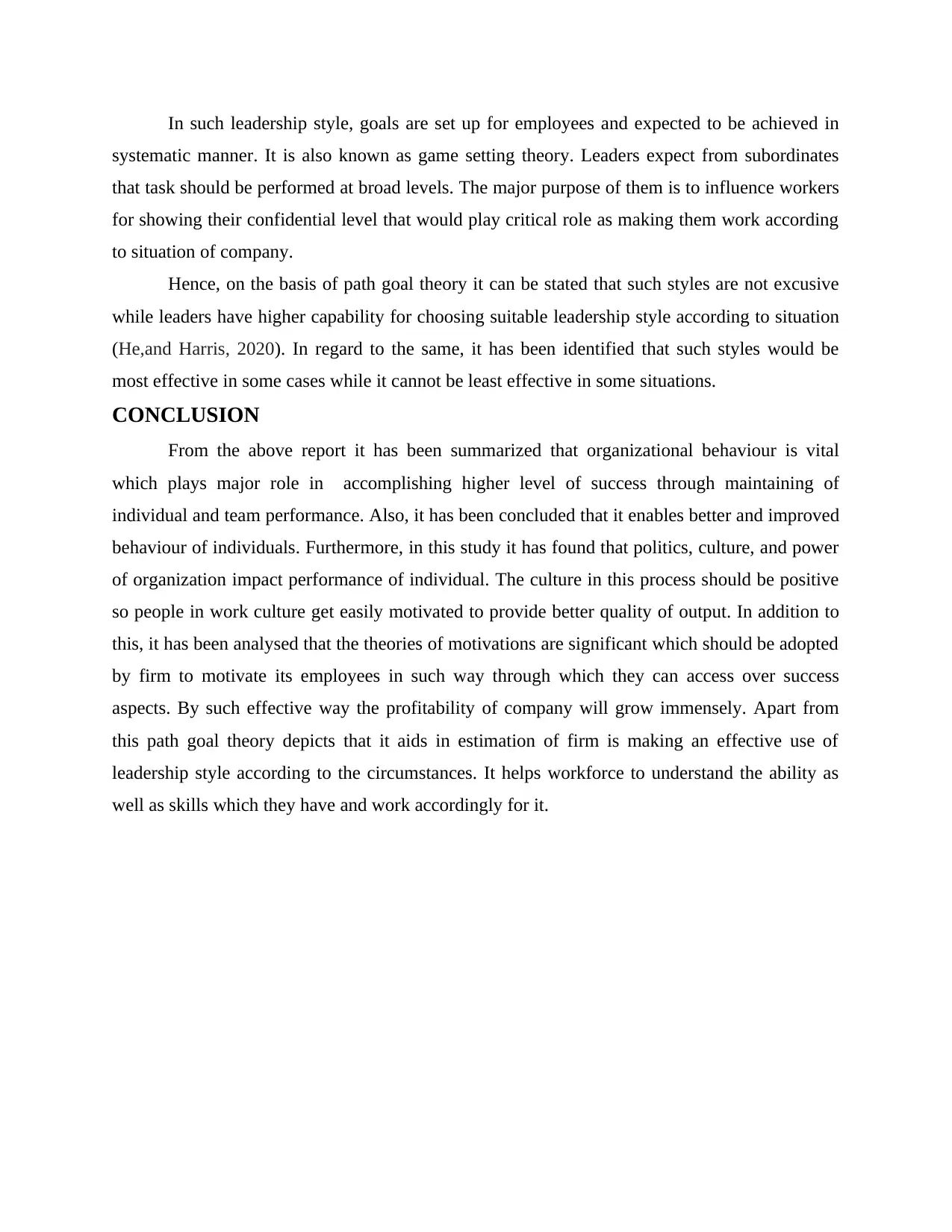
In such leadership style, goals are set up for employees and expected to be achieved in
systematic manner. It is also known as game setting theory. Leaders expect from subordinates
that task should be performed at broad levels. The major purpose of them is to influence workers
for showing their confidential level that would play critical role as making them work according
to situation of company.
Hence, on the basis of path goal theory it can be stated that such styles are not excusive
while leaders have higher capability for choosing suitable leadership style according to situation
(He,and Harris, 2020). In regard to the same, it has been identified that such styles would be
most effective in some cases while it cannot be least effective in some situations.
CONCLUSION
From the above report it has been summarized that organizational behaviour is vital
which plays major role in accomplishing higher level of success through maintaining of
individual and team performance. Also, it has been concluded that it enables better and improved
behaviour of individuals. Furthermore, in this study it has found that politics, culture, and power
of organization impact performance of individual. The culture in this process should be positive
so people in work culture get easily motivated to provide better quality of output. In addition to
this, it has been analysed that the theories of motivations are significant which should be adopted
by firm to motivate its employees in such way through which they can access over success
aspects. By such effective way the profitability of company will grow immensely. Apart from
this path goal theory depicts that it aids in estimation of firm is making an effective use of
leadership style according to the circumstances. It helps workforce to understand the ability as
well as skills which they have and work accordingly for it.
systematic manner. It is also known as game setting theory. Leaders expect from subordinates
that task should be performed at broad levels. The major purpose of them is to influence workers
for showing their confidential level that would play critical role as making them work according
to situation of company.
Hence, on the basis of path goal theory it can be stated that such styles are not excusive
while leaders have higher capability for choosing suitable leadership style according to situation
(He,and Harris, 2020). In regard to the same, it has been identified that such styles would be
most effective in some cases while it cannot be least effective in some situations.
CONCLUSION
From the above report it has been summarized that organizational behaviour is vital
which plays major role in accomplishing higher level of success through maintaining of
individual and team performance. Also, it has been concluded that it enables better and improved
behaviour of individuals. Furthermore, in this study it has found that politics, culture, and power
of organization impact performance of individual. The culture in this process should be positive
so people in work culture get easily motivated to provide better quality of output. In addition to
this, it has been analysed that the theories of motivations are significant which should be adopted
by firm to motivate its employees in such way through which they can access over success
aspects. By such effective way the profitability of company will grow immensely. Apart from
this path goal theory depicts that it aids in estimation of firm is making an effective use of
leadership style according to the circumstances. It helps workforce to understand the ability as
well as skills which they have and work accordingly for it.
⊘ This is a preview!⊘
Do you want full access?
Subscribe today to unlock all pages.

Trusted by 1+ million students worldwide
1 out of 15
Related Documents
Your All-in-One AI-Powered Toolkit for Academic Success.
+13062052269
info@desklib.com
Available 24*7 on WhatsApp / Email
![[object Object]](/_next/static/media/star-bottom.7253800d.svg)
Unlock your academic potential
Copyright © 2020–2025 A2Z Services. All Rights Reserved. Developed and managed by ZUCOL.


